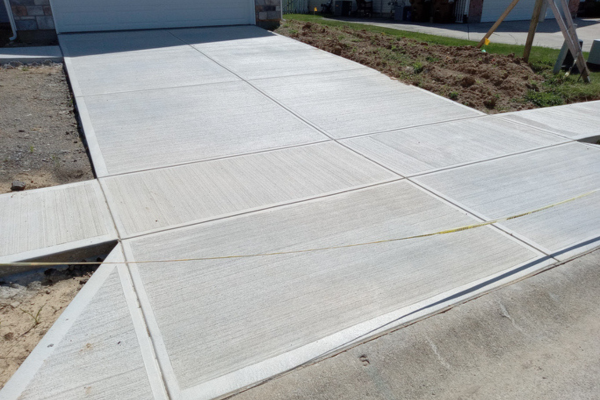
A concrete driveway is a durable surface made by mixing cement with aggregate materials like sand, gravel, or crushed stone. It can be finished in various ways, including plain, coloured, exposed aggregate, or stencilled, to suit different aesthetic preferences.
Best use
Concrete driveways are versatile and suitable for a wide range of applications. They are ideal for residential properties, providing a solid and stable surface for vehicles. The surface can be adapted for practical needs, such as different finishes for grip, and aesthetic needs, with options for various colours and designs.
Maintenance requirements
Concrete driveways require minimal maintenance. However, to ensure longevity and maintain appearance:
- Regular cleaning: Remove spills of oil, grease, or petrol promptly to prevent staining.
- Sealing: Apply a high-quality sealant every two years to protect the surface and enhance its appearance.
- Crack management: Inspect for cracks and address them promptly to prevent further damage.
Slope considerations
To ensure proper drainage, concrete driveways should have a minimum slope of 1% away from the house towards the street. The grade should not exceed 1:4 within the property boundary. Note that in some areas, there are restrictions on how steep a driveway can be; be sure to check with your local council about these limitations.
Installation process
The installation of a concrete driveway typically involves the following steps:
- Site preparation: Excavate the area to a depth of 200–300mm.
- Base layer: Create a base with at least 150mm of compacted hardcore material.
- Levelling: Cover the base with fine gravel and level it off.
- Compaction: Ensure good compaction with a vibrating plate or roller.
- Formwork: Install timber forms along the sides of the driveway, with stakes at regular intervals and at every join between timber forms.
- Concrete pouring: Lay the concrete, ensuring uniform slab height.
- Jointing: Insert shrinkage joints at least every 5–6m to avoid cracks forming. Control joints can also be cut within 24 hours of pouring.
- Curing: Keep vehicles off the driveway for at least seven days. If the weather is cool, extend this period by another 5 days.
Cost considerations
The cost of a concrete driveway can vary based on several factors:
- Size: The length and width of the driveway.
- Slope: Driveways with steeper slopes may incur higher costs.
- Finish: Plain concrete is the most cost-effective option. Decorative finishes like coloured, exposed aggregate, or stencilled concrete will increase the price.
To obtain an accurate quote, ensure you provide detailed information about these factors to your concreter.
Advantages
- Durability: Concrete driveways are long-lasting and can withstand heavy vehicle loads.
- Low maintenance: With proper installation and care, concrete driveways require minimal upkeep.
- Aesthetic flexibility: Various finishing options allow for customization to match the property’s style.
Disadvantages
- Cracking potential: Without proper jointing and maintenance, concrete can crack over time.
- Initial cost: The upfront cost may be higher compared to some other driveway materials.
- Installation time: The curing process requires time before the driveway can be used.




